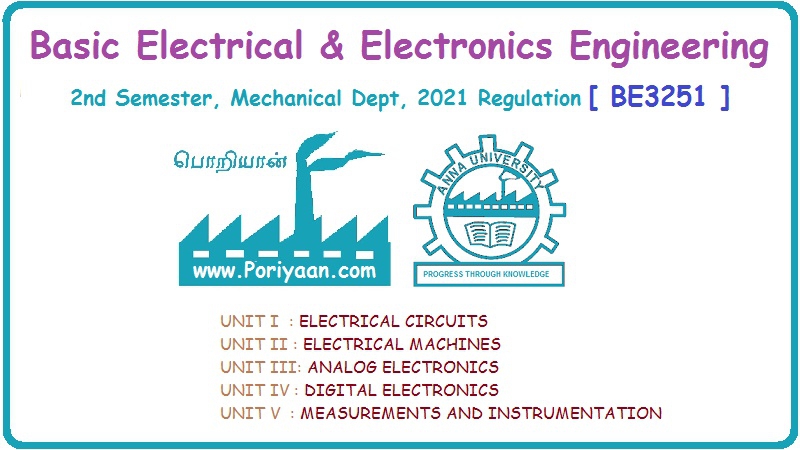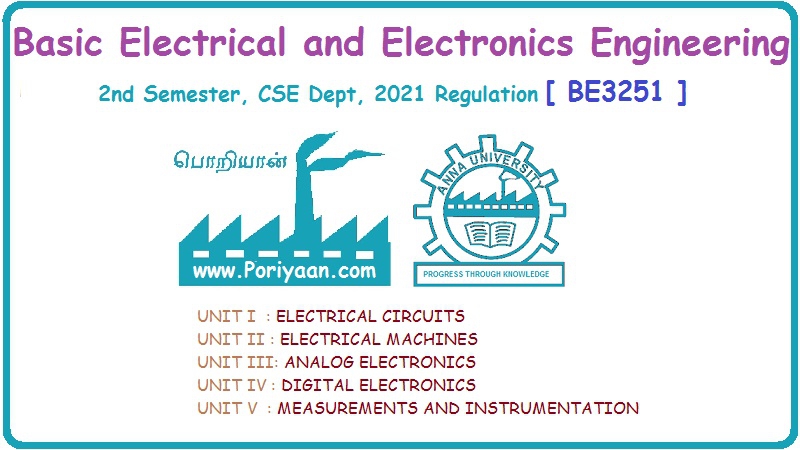Basic Electrical and Electronics Engineering: Unit II: Electrical Machines
Voltage Transformation Ratio (K)
with Solved Example Problems | Single Phase Transformer
E2/E1 = N2/N1 = K.This constant K is known as voltage transformation ratio.
VOLTAGE
TRANSFORMATION RATIO (K)
From
equation (1) and (2) we get
E2/E1
= N2/N1 = K
This
constant K is known as voltage transformation ratio.
(i)
If N2>N1 then transformer is called as step-up
transformer.
(ii)
If N2 < N1 then transformer is called as step-down
transformer.
For
an ideal transformer input VA = output VA
V1
I1 = V2 I2 (or)
I2/
I1 = V1/V2 = 1/K
Example: 13
The maximum flux density in the
core of a 250/3200 volts, 50 Hz single- phase transformer is 1.2 wb/m2.
It the emf per turn is 8 volts. Calculate (i) primary and secondary turns (ii)
area of the core.
Solution:
E1
=250 volts, E2 = 3200 volts, ƒ = 50 Hz, Bm = 1.2 wb/m2,
emf/turn = 8 volts
(i) E1 = N1
× emf induced/turn
Pppppppppppppppppppppppppppppp
(ii) We know that
E2
= 4.44 ƒN2 Bm A
3200
= 4.44 × 50 × 400 × 1.2 × A
A
= 0.03
Example: 14
A single-phase transformer has 400
primary and 1000 secondary turns. The net cross-sectional area of the core is
60 cm2. If the primary winding be connected to a 50 Hz supply at 520
V. Calculate
(i)
peak value of flux density in the core
(ii)
voltage induced in the secondary windings
Solution:
N1
= 400, N2 = 1000, A = 60 cm2, ƒ = 50 Hz, E1 =
520 V.
(i)
K = N2/N1
=
1000/400 = 2.5
E2/E1
= K
E2
= K E1
E2
= 2.5 × 520
E2
= 1300 volts
(ii)
E1 = 4.44 ƒ N1 Bm A
520
= 4.44 × 50 × 400 × Bm × 60 × 10-4
Bm
= 0.976 wb/m2
Example: 15
The primary and secondary windings
of a single-phase transformer are 350 and 35 respectively. If the primary is
connected to a 2.2 KV, 50 Hz supply, determine the secondary voltage on
no-load.
Solution:
N1
= 350, N2 = 35, E1 = 2.2 KV, ƒ = 50 Hz
K
= N2/N1 = 35/350 = 0.1
K
= 0.1
E2/E1
= K
E2
= K E1
E2
= 0.1 × 202 × 103
E2
= 220 volts
Example: 16
A 3000/200 V, 50 Hz, single-phase
transformer is built on a core having an effective cross-sectional area of 150
cm2 and has 80 turns in the low-voltage windings. Determine
(i) the value of the maximum flux
density
(ii) number of turns in high
voltage windings
Solution:
E2
= 3000 volts
E1
= 200 volts
ƒ
= 50 Hz
A
= 150 cm2
N1
= 80
E1
= 4.44 ƒN1 Bm A
200
= 4.44 × 50 × 80 × Bm × 150 × 10-4
Bm
= 0.75 wb/m2
E2
= 4.44ƒN2 Bm A
3000
= 4.44 × 50 × N2 × 0.75 × 150 × 10-4
N2
= 1200
Example: 17
A 3300/230 V, 50 Hz, 1-phase
transformer is to be worked at a maximum flux density of 1.2 wb/m2
in the core. The effective cross-sectional area of the transformer core is 150
cm2. Calculate the suitable values of the primary and secondary
turns.
Solution:
E1
= 230 volts
E2
= 3300 volts
ƒ
= 50 Hz
Bm
= 1.2 wb/m2
A
= 150 cm2
E1
= 4.44 ƒN1 Bm A
230
= 4.44 × 50 × N1 × 1.2 × 150 × 10-4
N1
= 58
E2
= 4.44 ƒN2 Bm A
3300
= 4.44 × 50 × N2 × 1.2 × 150 × 10-4
N2
= 825
Basic Electrical and Electronics Engineering: Unit II: Electrical Machines : Tag: : with Solved Example Problems | Single Phase Transformer - Voltage Transformation Ratio (K)
Related Topics
Related Subjects
Basic Electrical and Electronics Engineering
BE3251 2nd semester Mechanical Dept | 2021 Regulation | 2nd Semester Mechanical Dept 2021 Regulation
Basic Electrical and Electronics Engineering
BE3251 2nd Semester CSE Dept 2021 | Regulation | 2nd Semester CSE Dept 2021 Regulation

